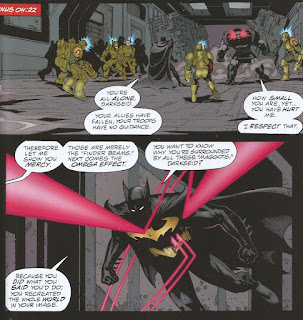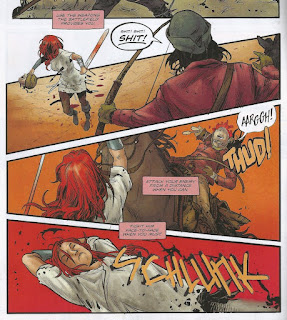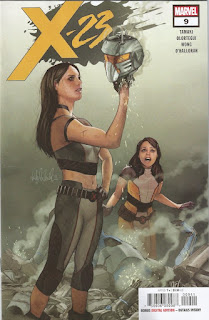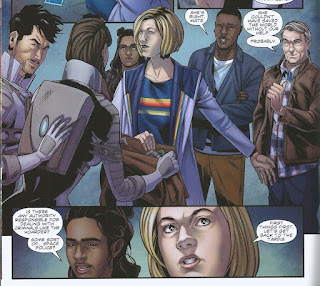Pick of the Brown Bag
February 6, 2019
by
Ray Tate
This week in the Pick of the Brown Bag, I review Batman, Doctor Who, Female Furies, the Immortal Hulk, Iron Man, Project Superpowers, Red Sonja, Wrong Earth and X-23. No time for the meatier reviews? No problem. I’m also on Twitter with fresh capsule critiques: #PickoftheBrownBag.
In the nineteen seventies, Jack Kirby returned to DC and gave the Powers That Be several gifts. One of those gifts was the Fourth World. A cosmic creation that served as home to the New Gods.
Jack Kirby’s co-creation Thor can be simply described as a modern updating of the Norse Deity. The New Gods were complex figures and cannot be so easily reduced. World mythologies inspired Kirby. He drew upon Shakespeare to frame the dialogue and evil plots most foul.
Kirby tapped into the Erich von Daniken craze. von Daniken was a popular ufologist whose fame grew due to a pseudo-documentary entitled In Search of Ancient Astronauts. Truth be told. If this work hadn’t been shown in classrooms all across America, including mine, and if the movie hadn’t been granted gravitas by the narration of Rod Serling, von Daniken might not have gained so much of a minute of fame.
The New Gods resided on two planets the paradisal New Genesis and dread Apokolips.
Kirby blended Nazi ideology to the world of Apokolips and asked a question. What would our planet in the future look like had the Nazis won World War II? The answer is unsettling. One wonders what horrors Jack Kirby saw during his G.I. years to affect his creativity so.
Most writers approach the Fourth World, with respect, often attempting to smoothly build on Kirby’s history and/or simply relate new stories about the New Gods.
Grant Morrison's Justice League
Female Furies writer Cecil Castallucci monkeys with the timeline of the New Gods and alters the canon for her own purpose, which is to leech off of the #MeToo movement.
Specifically Castallucci tries and fails to illicit sympathy from the reader for the most unsympathetic woman in DC comics. Granny Goodness.
The canonical Granny Goodness first appears in Kirby’s Mister Miracle. She is a lieutenant in Darkseid’s army. The head of an orphanage dedicated to molding young minds into psychopaths.
This is the logical abhorrent conclusion reached when combining Nazi Breeding Houses and the Hitler Youth Corps. It is not a normal orphanage as Castallucci, bereft of originality, reimagines.
Nor is the position meant to be Darkseid’s affront to Granny Goodness. Darkseid trusted Granny Goodness. Granny was privy to the original machination which secured a truce between New Genesis and Apokolips. Because Darkseid always intended to break that pact.
Her hatred of Scott Free is due to the fact that he wasn’t supposed to escape with such gusto.
Nobody foresaw Scott Free becoming the inspirational escapologist Mister Miracle, nor did Granny in her wildest nightmares acknowledge the possibility that her greatest achievement Big Barda would fall in love with Scott and marry him.
That love acts like a knife to the totalitarian dreams of Granny Goodness. Big Barda and Mister Miracle furthermore persuade the Female Furies to jump ship.
So, no. It doesn’t start here.
It started and continued elsewhen by the New Gods creator Jack Kirby.
What starts here is the numbing and smearing of Kirby’s majesty. Castallucci’s story begins by retro-planting Granny Goodness in the plot to kill Darkseid’s mother Heggra.
In this retread, Desaad isn’t the instrument of her demise. He simply takes credit, which is nonsense.
Darkseid solely colluded with Desaad to kill Heggra. Otherwise, you break the rhythm of the elliptical poetry. Heggra ordered Desaad to kill Darkseid’s great, forbidden love Suli. In turn, Darkseid ordered Desaad to kill Heggra. It’s a chain of death and revenge. Heggra ordered Darkseid to marry Tigra, not The Tigra, and she gives him the son Orion. Orion is destined to kill Darkseid in final battle. The son of the mother Heggra gave to Darkseid is the instrument of his demise. There is no room in this chain for Granny Goodness.
That said. Despite what Castallucci thinks, there is room for Granny Goodness in Darkseid’s chain of command. Her role is vital. She trains the soldiers from the ground up. She’s not just in charge of the Female Furies. The Female Furies are her elite guard. Even the most casual reader of Kirby’s stories would know this. Steppenwolf commands the adult soldiers, all graduates from Granny’s academy. Desaad and Glorious Godfrey, of all people would not, could not have a thing to say about Granny Goodness’ position in Darkseid’s world. This bizarre scene never would have occurred in Kirby's Kingdom. Not a shred of it. Castullucci next portrays Darkseid as a sexual harasser if not a rapist.
Darkseid’s two relationships—Tigra and Suli—were consensual. When Geoff Johns considered Darkseid in the light of the New 52, his relationship with the Amazon Myrina also was consensual. Rape and sexual harassment is beneath Darkseid. Darkseid operates on his own code.
When first we meet the Forever People, they seek their missing comrade, Beautiful Dreamer. Self-explanatory. Darkseid didn’t kidnap her to be used in the bed. He abducted her because he believed her mind could solve the Anti-Life Equation. As it turns out her mind is too "unique."
This is Darkseid. He does not think like a human. He is beyond humanity. The banality of Castallucci’s scene, the idiocy of the dialogue all characterizes a different kind of despot. Not one seen in Kirby’s universe. Battle would not make Darkseid hunger for sex. That’s not how he behaves. This is how Darkseid behaves.
Castallucci also takes a sidetrack to attack beauty contests for some reason. Let me break it to you gently. Beauty contests aren’t misogynist nor even sexist. They’re a means for women willing to enter to get out of whatever bind they’re in. The prizes vary, but in a pageant like Miss America, each contestant gets a scholarship of varying amounts, with the winners getting an even greater cut. This however is immaterial because Darkseid and his cronies would never hold such a contest. Once again. It’s too puerile, too human.
I also love that the artist felt the need to beautify Mad Harriet for her to stand in such a contest. Adriana Melo turns her into an exotic Star Trek extraterrestrial woman rather than stick with Kirby's original Night Gallery refugee.
Even when trying to strike a misguided blow for feminism, this book fails miserably. Kirby wasn’t shy about drawing beautiful women, but Kirby’s illustrations and his imagination are far more progressive than Castallucci and Adriana Melo can ever hope to be.
Previously, the delivery men ogled Barda while she stretched, but Kirby’s aim was to give Barda the last laugh. He furthermore demonstrated that Barda did not know why the men behaved like they did. Again, Kirby is relating a story about aliens with different social mores than ours.
Castallucci's story gets even worse when the butcher Willik appears to buy Auralie’s favors from Granny Goodness.
I’m not going to complain that Castallucci brought Auralie and Willik back back from the dead. That’s standard procedure. Actually, I am. Both of these two characters were important in Mister Miracle. In the graphic at the beginning of the review depicting the shock boots, the chortling trooper is Willik. Auralie his victim. Auralie’s death forces Barda to question her orders, and she helps Scott Free conduct his first escape.
Let’s however push that aside for the moment. There’s so much wrong with Castallucci's entire scenario. Number one, Apokolips has no monetary system. They don’t buy goods on Apokolips. Their technology provides all that’s necessary. Number two, Granny Goodness would never allow a trumped up guard that she probably conditioned to bribe her. Number three, Granny doesn’t need money. Number four, Granny has enough pride in her Female Furies, enough dignity to kill Willik without hesitation should he have suggested such a barter. Female Furies is such wretched dreck and you reader deserve better.
Incidentally, should this review somehow get in the hands of a singing chorus of the He-Man-Woman-Hater’s Clubs around the internet, let me assure you. This is a review of Female Furies. It's not a review of #MeToo, which I support. It's not a review of feminism, a school that I attend. It's not a review of gender equality, which is the only way humanity can ever reach a Utopian future.
I am not one of you. I am not like you. You are a virulent plague. I mean this sincerely, when I say Fuck You.
Believe it or not, gentle reader, but the rest of the reviews are a lot shorter, not due to the quality of the books. Several are conclusions to story arcs and filled with action and denouement goodness. Others surprise. They share secrets that I'll keep. In addition, a lot of the writers just let the art do the talking for them.
Amy Chu and Carlos Gomez made one of the perfect teams for Red Sonja. I compare them favorably with Frank Thorne. Mark Russell's been making a name for himself with Snagglepuss and The Lone Ranger, which I continue to enjoy. His Red Sonja bears several similarities to The Lone Ranger.
Dark humor proliferates the villain's camps. They appear to be civilized only to reveal themselves as barbarians.
Giving him the sack takes on a new literal meaning, and I'm sure Russell relished the pun.
As to the She-Devil herself. She departs from the Ranger, of course, but as well as the lusty warrior depicted by Chu. Russell opts for a more brutal Red Sonja.
The depiction is favorable to some of the more sanguine Italian gladiator movies of the nineteen seventies. The art is more matter-of-fact realistic than stylish embodiments of female anatomy. It's neither an improvement or a diminishment. It's just different.
Sonja comes from a different origin. She returns to Hyrkania somewhat broken. She spent most of her time studying with a sword master named Domo of Khitai. The villagers know of her and raise her to Queen, but as the story unfolds, the reader learns this is not an honor but a survival tactic.
Dark humor proliferates the villain's camps. They appear to be civilized only to reveal themselves as barbarians.
Giving him the sack takes on a new literal meaning, and I'm sure Russell relished the pun.
As to the She-Devil herself. She departs from the Ranger, of course, but as well as the lusty warrior depicted by Chu. Russell opts for a more brutal Red Sonja.
The depiction is favorable to some of the more sanguine Italian gladiator movies of the nineteen seventies. The art is more matter-of-fact realistic than stylish embodiments of female anatomy. It's neither an improvement or a diminishment. It's just different.
Sonja comes from a different origin. She returns to Hyrkania somewhat broken. She spent most of her time studying with a sword master named Domo of Khitai. The villagers know of her and raise her to Queen, but as the story unfolds, the reader learns this is not an honor but a survival tactic.
After defending she and Gabby from the Stepford Cuckoos, Laura returned to hunting down those that used her genome for ill will. That led to a series of scientist murders and the killer, who turned out to be another clone.
Despite Laura’s warnings, Gabby attempts to bond with the cyborg. It seems as though her soft touch is getting through to her.
Meanwhile, Laura investigates the corporation Medi-X-Tronics, a biotech corporation that’s sending a signal to Cyborg Laura. Unbeknownst to Laura, her incursion is expected. This allows for some whistle worthy artwork courtesy of Diego Olortegui, enhanced by Walden Wong, J.P. Mayer and/or Scott Hanna as well as colorist Chris O’Halloran.
X-Wolverine, see what I did there, Laura doesn’t really register surprise and shock when being betrayed. It’s one of her most pragmatic qualities, and a neat nuance of characterization by writer Mariko Tamaki.
Tamaki’s Tomb Raider impressed, but I think she would have been better off without the game villains. In X-23, she needed to step up to meet the challenge that superb X-23 scribe Tom Taylor left behind. She does so with aplomb.
Iron Man is notable for several things. What caught my attention most was the cameo by the Soviet Super-Soldiers, introduced as a team in late seventies Iron Man.
Otherwise, it’s a bunch of beauteous artwork by Valerio Schiti narrating the war between Iron Man and his virtual reality technology suborned by the Controller.
The story develops into a new direction toward the end where malicious a.i. appears to be behind the abduction of Amanda, Stark's bio-mom, and the continued wear of the eScape game.
The first multi-chapter story of the Immortal Hulk ends beautifully with a re-affirmation of love and friendship.
The defeat of the Big Bad--namely Bruce Banner's father--isn't as important as the means through which he loses. It's touching. It's historically important, and it's The Hulk.
Batman can only be read by those who do not care about Heroes in Crisis, or those already aware of the Heroes in Crisis fallout. There's no two ways about it.
This is also true of the most current issues of Green Arrow, not reviewed because it will be cancelled with issue fifty and reveals even more than Batman about Heroes in Crisis. Suffice to say that forty-eight and forty-nine of Green Arrow comprise a strong tale with visually arresting artwork pitting GA and Black Canary against a souped up Count Vertigo. It's more that, but that's all I can divulge.
The very first page of Batman is a spoiler. Batman attempts to do an autopsy on one of the Heroes in Crisis victims but abandons his task before a single cut of the scalpel. He cannot deny being affected by the loss. His trauma may be playing tricks with his mind.
Batman begins replaying the Sanctuary tragedy and mentally miscues the images of the victims. This occurs while he battles amidst the Justice League against Amazo bots to the tune of holy crap Guillem March artistry.
Mera apparently continues to be a Justice League member, and that suits me fine. It hurts that Flash writer Joshua Williamson puts together a better, more comprehensible mini-adventure for the Justice League than Scott Snyder's entire run so far. Not that Williamson is a bad writer. I just miss Justice League.
Batman's "hallucinations" increase, and suddenly, he gets a call from Alfred. This may be unconnected, or perhaps the product of a competing timeline. Booster Gold plays a prominent part in Heroes in Crisis, and Booster Gold is a big gold button that can reset the tragic events, prevent them from happening.
Alfred's call takes Batman to the Flash Museum in Central City, where he's instrumental in saving a father and daughter from being squashed.
Once again, the New 52 writers demonstrate that Batman is unabashedly a superhero. I mean. It's really going to put a dent in his urban legend status when two eye witnesses attest to being saved by the Caped Crusader.
The culprit--this is no spoiler--is Gotham Girl who is off her flipping rocker. I have no idea when this happened. Last I saw, and according to Tom King, Batman used the Psycho-Pirate's Medusa Mask to repair Gotham Girl's mind. King later used only a single image to suggest otherwise, but if a deeper story unfolded, I'm not aware of it.
When Flash arrives late, as he is wont to do when any other superhero is on the scene, he provides succor for the crowd of survivors and confronts Batman about Gotham Girl. He also reminisces about the good old days between he, Batman and other parties. Williamson joined King on The Button, a phenomenal Batman/Flash team-up that payed off more than Geoff Johns yet to be finished Doomsday Clock. This looks like the start of another beauty.
The defeat of the Big Bad--namely Bruce Banner's father--isn't as important as the means through which he loses. It's touching. It's historically important, and it's The Hulk.
Batman can only be read by those who do not care about Heroes in Crisis, or those already aware of the Heroes in Crisis fallout. There's no two ways about it.
This is also true of the most current issues of Green Arrow, not reviewed because it will be cancelled with issue fifty and reveals even more than Batman about Heroes in Crisis. Suffice to say that forty-eight and forty-nine of Green Arrow comprise a strong tale with visually arresting artwork pitting GA and Black Canary against a souped up Count Vertigo. It's more that, but that's all I can divulge.
The very first page of Batman is a spoiler. Batman attempts to do an autopsy on one of the Heroes in Crisis victims but abandons his task before a single cut of the scalpel. He cannot deny being affected by the loss. His trauma may be playing tricks with his mind.
Batman begins replaying the Sanctuary tragedy and mentally miscues the images of the victims. This occurs while he battles amidst the Justice League against Amazo bots to the tune of holy crap Guillem March artistry.
Mera apparently continues to be a Justice League member, and that suits me fine. It hurts that Flash writer Joshua Williamson puts together a better, more comprehensible mini-adventure for the Justice League than Scott Snyder's entire run so far. Not that Williamson is a bad writer. I just miss Justice League.
Batman's "hallucinations" increase, and suddenly, he gets a call from Alfred. This may be unconnected, or perhaps the product of a competing timeline. Booster Gold plays a prominent part in Heroes in Crisis, and Booster Gold is a big gold button that can reset the tragic events, prevent them from happening.
Alfred's call takes Batman to the Flash Museum in Central City, where he's instrumental in saving a father and daughter from being squashed.
Once again, the New 52 writers demonstrate that Batman is unabashedly a superhero. I mean. It's really going to put a dent in his urban legend status when two eye witnesses attest to being saved by the Caped Crusader.
The culprit--this is no spoiler--is Gotham Girl who is off her flipping rocker. I have no idea when this happened. Last I saw, and according to Tom King, Batman used the Psycho-Pirate's Medusa Mask to repair Gotham Girl's mind. King later used only a single image to suggest otherwise, but if a deeper story unfolded, I'm not aware of it.
When Flash arrives late, as he is wont to do when any other superhero is on the scene, he provides succor for the crowd of survivors and confronts Batman about Gotham Girl. He also reminisces about the good old days between he, Batman and other parties. Williamson joined King on The Button, a phenomenal Batman/Flash team-up that payed off more than Geoff Johns yet to be finished Doomsday Clock. This looks like the start of another beauty.
This is the conclusion to the first volume of The Wrong Earth. Dragonflyman is a 1960s styled crimefighter. Dragonfly is a dark, edgier incarnation of the same. When The One uses a magic mirror to trade places with his psychopathic counterpart in Dragonfly's universe, the Dragonflies follow. They hoped to use the mirror to return to their earth proper, but events in previous issues make that impossible. In many ways this is a cleanup issue, yet it still entertains as the Dragonflies settle on the wrong earth.
The more corrupt earth seems to need an optimistic superhero like Dragonflyman. His recruitment of a new Stinger is in his mind just the right thing to do, and Stinger needs the break, having been horribly used by The One. Alternately, Dragonfly need the shiny earth to become the hero he used to be.
There's always going to be some turbulence as our champions adapt to their environment. As it turns out, most of these ripples can be fixed the same way, and neither Dragonfly is above the method.
The more corrupt earth seems to need an optimistic superhero like Dragonflyman. His recruitment of a new Stinger is in his mind just the right thing to do, and Stinger needs the break, having been horribly used by The One. Alternately, Dragonfly need the shiny earth to become the hero he used to be.
There's always going to be some turbulence as our champions adapt to their environment. As it turns out, most of these ripples can be fixed the same way, and neither Dragonfly is above the method.
After a misfire from Warren Ellis, Dynamite sought the services of Rob Williams. Williams went back to the original thoughts of Alex Ross and Jim Krueger and restored Project Superpowers to a place of respect.
For those who haven’t been paying attention, Project Superpowers consists of new adventures of 1940s public domain super-heroes such as Cat Man, Black Venus, The Flame and Dyna-Man. For this go around, Williams relied on the fan favorites from the previous series: Black Terror, Death-Defying Devil (the original Dare-Devil), Masquerade (Miss Masque) and the Green Lama. He also added the Mighty Samson for great fun and centered the story around the American Spirit. Essentially a ghostly Stars and Stripes. A possible stand-in for Uncle Sam, who likely DC Comics owns.
The current story examines the loss of heroic enthusiasm resulting from confronting the modern era. Miss Masque in particular experiences the inequities between the sexes that her team, and her era did not foster. While sexism and misogyny exist throughout history, the social forces didn’t intensify until the 1950s. Quelling only briefly in the 1960s and 1970s.
At the same time, a cosmic being named Pandora seeks his box. It’s the same box that trapped our heroes for decades and also granted them extra powers. This issue is the conclusion of the Superpowers’ battle against Pandora, for the sake of the earth and the freedom of the cosmos.
The story impresses with Miss Masque coming up with the plan to defeat the seriously Big Bad.
Pandora used the Death-Defying Devil shamelessly. The Devil is not really a man. He’s a uniform imbued with the essence of the man who wore the costume. However, he’s been above board ever since coming out of Pandora’s Box. It’s lovely that none of the experienced characters blame him for his puppeteered actions.
Artist Sergio Davila, intimately familiar with the Superpowers, bestows resonance to these echoes of the past. With colorist Ulises Arreola, every page of Project Superpowers is a gorgeous display of superheroes battling evil. Not also-rans against some generic foe.
The Doctor, Yaz, Ryan and Graham met up with a human time traveler using the dirty, nasty travel device of a Time Agent to trip the ages fantastic.
Wrist-worn Vortex Manipulators have a bad reputation in Doctor Who, and the device plays a clever part in the conclusion of Jody Houser's and Rachel Stott's first Jodie Whittaker Doctor tale.
Perkins the human time traveler became separated from his partner Dr. Schultz when she tricked him into using the Vortex Manipulator to escape. They're running and rebelling from a being called the Hoarder.
He's just what his name says. Although he doesn't just hoard objects. He collects children. That was the final straw for Perkins and Schultz, and it looks like the Hoarder will win. His infection gets the better of Schultz, who slowly and painfully dies. Nah.
The Doctor undoes everything the Hoarder inflicts, making a sound enemy in the process.
One the features that distinguish new Doctor Who--i.e. Paul McGann through Jodie Whittaker--is that the creative team behind the series draw attention to the Doctor's amazing stunts. There's buildup and performance.
Hauser uses one of the Doctor's more passive powers to announce her arrival, instill hope in the prisoners and foreshadow the villain's defeat. It's a brilliant, characteristic moment.
























































No comments:
Post a Comment